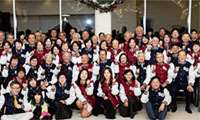Computers Learning What Makes People Smile, and Spend
The technology can be used in hospitals, shopping malls, schools, subway platforms, offices and stadiums. Machines never blink.
All of which could be helpful - or alarming.
“Machines will definitely be able to observe us and understand us better,” said Hartmut Neven, a computer scientist and vision expert at Google. “Where that leads is uncertain.”
Google has been both at the forefront of the technology’s development and a source of the anxiety surrounding it. Its Street View service, which lets Internet users zoom in on a location, faced privacy complaints. Google will blur out people’s homes at their request.
With Google’s Goggles application, people can take a picture with a smartphone and search the Internet for matching images. The company’s executives excluded a facial-recognition feature, which they feared might be used to find personal information on people.
Scientists predict that people will increasingly be surrounded by machines that can not only see but also reason about what they are seeing.
The uses, noted Frances Scott, an expert in surveillance technologies, could allow the authorities to spot a terrorist, identify a lost child or locate an Alzheimer’s patient who has wandered off.
Millions of people now use products that show the progress that has been made in computer vision. The major online photo-sharing services have all started using face recognition.
Kinect, an add-on to Microsoft’s Xbox 360 gaming console, is a striking advance for computer vision in the marketplace. It uses a digital camera and sensors to recognize people and gestures; it also understands voice commands.
With Kinect, “ technology more fundamentally understands you, so you don’t have to understand it,” said Alex Kipman, an engineer who helped design it.
‘Please Wash Your Hands’
Three months ago, Bassett Medical Center in Cooperstown, New York, began experimenting with computer vision. Small cameras on the ceiling monitor patients’ movements and track people going in and out of the room.
The first applications of the system, designed by General Electric, are reminders and alerts. Doctors and nurses are supposed to wash their hands before and after touching a patient; lapses contribute significantly to hospital- acquired infections, research shows. When someone forgets, a voice declares, “Pardon the interruption. Please wash your hands.”
The system can recognize movements that indicate when a patient is in danger of falling out of bed, and alert a nurse. More features can be added, like software that analyzes facial expressions for signs of severe pain or other distress, said Kunter Akbay, a G.E. scientist.
It is too early to say whether the computer vision will be cost-effective.
Mirror, Mirror
Daniel J. McDuff, a graduate student, stood at a two-way mirror at the Massachusetts Institute of Technology’s Media Lab. After 20 seconds , a figure - 65, the number of times his heart beat per minute - appeared on the mirror. Behind the mirror, a Web camera fed images of Mr. McDuff to a computer whose software tracked the blood flow in his face.
The software separates the video images into three channels - for the basic colors red, green and blue. Changes to the colors and to movements made by tiny contractions and expansions in blood vessels in the face are not apparent to the human eye.
“Your heart-rate signal is in your face,” said Ming-zher Poh, an M.I.T. graduate student. Other vital signs, including breathing rate and blood pressure, should leave similar clues.
The pulse-measuring project, described in research published in May by Mr. Poh, Mr. McDuff and Rosalind W. Picard, a professor at the lab, is just the beginning, Mr. Poh said. Computer vision and clever software, he said, make it possible to monitor humans’ vital signs at a digital glance. Daily measurements can reveal that, for example, a person’s risk of heart trouble is rising. “In the future it will be in mirrors,” he said.
Faces can yield all sorts of information to computers. At M.I.T, Dr. Picard and a research scientist, Rana el-Kaliouby, have applied facial-expression analysis software to help people with autism better recognize emotional signals.
The two women founded Affectiva, a company in Waltham, Massachusetts, that is marketing its facial-expression analysis software to manufacturers of consumer products, retailers, marketers and movie studios.
John Ross, chief executive of Shopper Sciences, a marketing research company, said Affectiva’s technology promises to give marketers an impartial reading of the sequence of emotions that leads to a purchase. “You can see and analyze how people are reacting in real time, not what they are saying later, when they are often trying to be polite” in focus groups, he said. The software, Mr. Ross said, could be used in store kiosks or with Webcams. Shopper Sciences, he said, is testing Affectiva’s software with a major retailer and an online dating service.
Watching the Watchers
Maria Sonin, 33, an office worker in Waltham, Massachusetts, watched a movie trailer while Affectiva’s software calibrated her reaction. The software tracked movements on a couple of dozen points on her face . To the human eye, Ms. Sonin appeared to be amused. The software agreed, said Dr. Kaliouby, though it used a finer-grained analysis, like recording that her smiles were symmetrical (signaling amusement, not embarrassment) .
Christopher Hamilton, a technical director of visual effects, says facial- expression analysis technology “makes it possible to measure audience response with a scene-by-scene granularity that the current surveyand- questionnaire approach cannot.” A director could find, for example, that although viewers liked a movie over all, they did not like two or three scenes. Or he could learn that a particular character did not inspire the intended emotional response.
The challenge of computer vision arises from the rapid spread of lessexpensive yet powerful technologies.
At work or school, the technology opens the door to a computerized supervisor that is always watching.
More subtle could be the effect of a person knowing that he is being watched. It could be beneficial: a person reconsiders before committing a crime. But might it also lead to a society that is less spontaneous, less creative, less innovative?
As Hany Farid, a computer scientist at Dartmouth College in New Hampshire, said, “With every technology, there is a dark side.”
By STEVE LOHR
스마터리빙
more [ 건강]
[ 건강]이제 혈관 건강도 챙기자!
[현대해운]우리 눈에 보이지 않기 때문에 혈관 건강을 챙기는 것은 결코 쉽지 않은데요. 여러분은 혈관 건강을 유지하기 위해 어떤 노력을 하시나요?
 [ 건강]
[ 건강]내 몸이 건강해지는 과일궁합
 [ 라이프]
[ 라이프]벌레야 물럿거라! 천연 해충제 만들기
 [ 건강]
[ 건강]혈압 낮추는데 좋은 식품
[현대해운]혈관 건강은 주로 노화가 진행되면서 지켜야 할 문제라고 인식되어 왔습니다. 최근 생활 패턴과 식생활의 변화로 혈관의 노화 진행이 빨라지고
사람·사람들
more많이 본 기사
- 뉴욕 백화점서 아기 기저귀 갈던 엄마, 정신질환자에 흉기피습
- ‘인니 수마트라섬 대홍수’ 사망자 1천명 넘어…218명 실종
- 한소희, 韓 떠나기 전 의미심장 SN… 1
- 시리아서 미군 피격, 3명 사망… “시리아군 내 극단주의자 소행”
- 美, 카리브해 군사자산 확대… “베네수엘라에 지상·전자전 위협”
- 김연아♥고우림, 사랑하니 닮아가네..예쁜 커플사진
- 트럼프 “태국·캄, 교전 중단 합의”…태국 “군사 작전 계속”
- 韓 탁구 최초 역사… 신유빈-임종훈, 세계랭킹 1위+파리올림픽 金 듀오 꺾고 WTT 파이널스 우승
- 트럼프 “인디애나 선거구 조정 반대한 공화의원들, 교체돼야”
- ‘손흥민 벽화 3일 만에 그린’ 예술가, SON과 감격 만남 후 “내 아들의 영웅이자 아시아 유산” 찬사
- 이정후 태극마크 ‘청신호’ 떴다! 스타 출신 SF 사장 “야수보단 투수가 WBC 위험”→걸림돌 사라졌다
- 與, 은행법 처리뒤 ‘경찰관직무집행법’ 상정…국힘 또 필버
- 국방부 “시리아서 공격받아 미군 2명 사망…공격범 사살”
- TV 나와 암투병 근황 공개한 찰스 英국왕… “조기검진 중요해요”
- 내란특검, 김용현 추가 기소… “HID요원 등 명단 노상원에 넘겨”
- 선교사 아들 가나대사로 금의환향… “… 1
- 변요한♥티파니, 결혼 전제 열애 인정
- 신혼부부 ‘역대 최저’ 24%는 3억 이상 대출
- 한국 교사 10명, 페어팩스 초등교 배치
- 송지효 “’런닝맨’ 출연 중 8년 ♥장기 연애했다” 폭탄 고백..멤버 모두 ‘충격’
- 한국도 참여한 美주도 AI 동맹 “비… 1
- 굽히지 않는 젤렌스키…트럼프에 역제안 카드로 레드라인 저지
- “현실 기반 대북정책 필요”
- 초강경 추방 드라이브… 한인사회 불안감 확산
- 기아 EV5, 넷플 ‘나이브스 아웃’ 협업 캠페인…세계 6개국 진행
- ‘나혼산’ 박나래, 흔적도 없이 하차… 1
- “마약밀매·인신매매 등 국제범죄 척결” ‘국토안보 태스크포스’ 뉴욕지부 출범
- “귀금속 역사상 가장 극적인 재평가”…올해는 銀이 金 앞섰다 [공준호의 탈월급 생존법]
- 통일교 특검 대신 “내란 2차 특검”… 민주당 ‘철벽 방어’
- ‘오바마케어 보조금’ 올해 말 종료 가능성 ↑ 커져
- 뉴욕증시, 브로드컴 비관론에 AI 테마 ‘와르르’…나스닥 1.7%↓ 마감
- ‘정국 열애설’에 뿔난 아미 ‘워워’..BTS 완전체, 전역→웃으며 연습실 회동 첫 인증샷
- “머스크의 X, 3분기 매출 7억 달러대…순손실 5억 달러대”
- 김지민 “유부남과 불륜, 날 알리바이로 이용”..친구와 손절한 사연 [이호선의 사이다]
- “보안사고 반복 땐 과징금 폭탄”… 해킹과 전면전 선포한 과기부
- 소셜연금 NY 2,018달러·NJ 2,190달러
- 제미나이 추격 오픈AI 새 모델 GPT-5.2 조기 공개
- 한화, 호주 방산업체 최대주주 된다
- “’삐빅’ 비트코인으로 결제할게요”…맥도날드·편의점서도 쓴다는 ‘이곳’, 어디?
- 美 레전드 깜짝 전망 “한국, 북중미 월드컵 A조 1위로 32강”
- 종묘 일대 세계유산지구로 세운4구역 개발 영향 줄까
- ‘양육비 미지급’ 김동성 “내가 月700만원? 통장 압류된 신용불량자”
- AI공급망 동맹 ‘팍스 실리카’ 8개국 참여
- “엔비디아, 中수요 반영 H200 증산”…일각선 “中, 수입거부할듯”
- 김하성-ATL, 이대로 헤어지나→윈터미팅서만 무려 1005억 지출해버렸다
- PCB, 전국 최고 중소은행 ‘올스타’ 선정
- 국힘·개혁신당 “통일교 특검 수용하라”…與 “정치공세·물타기”
- 美지상작전 임박설 속 베네수 이민자 송환 중단 놓고 ‘혼선’
- ‘고가 논란’ 북중미 월드컵 티켓, 판매 첫날 500만건 신청
- “한국, 재래식 방위주도” 한미 핵협의그룹 첫 명시
1/5지식톡

-
 테슬라 자동차 시트커버 장착
0
테슬라 자동차 시트커버 장착
0테슬라 시트커버, 사놓고 아직 못 씌우셨죠?장착이 생각보다 쉽지 않습니다.20년 경력 전문가에게 맡기세요 — 깔끔하고 딱 맞게 장착해드립니다!장착비용:앞좌석: $40뒷좌석: $60앞·뒷좌석 …
-
 식당용 부탄가스
0
식당용 부탄가스
0식당용 부탄가스 홀세일 합니다 로스앤젤레스 다운타운 픽업 가능 안녕 하세요?강아지 & 고양이 모든 애완동물 / 반려동물 식품 & 모든 애완동물/반려동물 관련 제품들 전문적으로 홀세일/취급하는 회사 입니다 100% …
-
 ACSL 국제 컴퓨터 과학 대회, …
0
ACSL 국제 컴퓨터 과학 대회, …
0웹사이트 : www.eduspot.co.kr 카카오톡 상담하기 : https://pf.kakao.com/_BEQWxb블로그 : https://blog.naver.com/eduspotmain안녕하세요, 에듀스팟입니다…
-
 바디프렌드 안마의자 창고 리퍼브 세…
0
바디프렌드 안마의자 창고 리퍼브 세…
0거의 새제품급 리퍼브 안마의자 대방출 한다고 합니다!8월 23일(토)…24일(일) 단 이틀!특가 판매가Famille: $500 ~ $1,000Falcon: $1,500 ~ $2,500픽업 & 배송직접 픽업 가능LA…
-
 바디프렌드 안마의자 창고 리퍼브 세…
0
바디프렌드 안마의자 창고 리퍼브 세…
0거의 새제품급 리퍼브 안마의자 대방출 한다고 합니다!8월 23일(토)…24일(일) 단 이틀!특가 판매가Famille: $500 ~ $1,000Falcon: $1,500 ~ $2,500픽업 & 배송직접 픽업 가능LA…
케이타운 1번가
오피니언

22기 LA평통 출범에 거는 기대

연말 시즌 사기·범죄 경계해야
 메건 매카들 워싱턴포스트 칼럼니스트
메건 매카들 워싱턴포스트 칼럼니스트 [메건 매카들 칼럼] 장편영화의 마지막 챕터인가
 김미선 서북미문인협회 회장시인
김미선 서북미문인협회 회장시인 [한국춘추] 하늘을 계산한 사람들, 칠정산
 이희숙 시인·수필가
이희숙 시인·수필가 [금요단상] 그을린 자리에서 다시
 심상용 / 서울대 미술관장
심상용 / 서울대 미술관장 [미술 다시보기] 지옥에 대하여
 서정명 / 서울경제 기자
서정명 / 서울경제 기자[만화경] 주한미군과 ‘도련선 리스크’
 한 영 재미수필가협회 회장
한 영 재미수필가협회 회장 [한영의 독서칼럼] 불안한 사람들
 정영현 서울경제 테크성장부장
정영현 서울경제 테크성장부장 [여명] 콘크리트가 데이터가 됐을 뿐, 달라진 게 없다
1/3지사별 뉴스

“마약밀매·인신매매 등 국제범죄 척결” ‘국토안보 태스크포스’ 뉴욕지부 출범
연방 국토안보부가 10일 ‘국토안보 태스크포스’(HSTF) 뉴욕지부를 출범시켰다.HSTF는 마약 카르텔, 인신매매, 자금세탁, 갱단 등 국제범…
‘오바마케어 보조금’ 올해 말 종료 가능성 ↑ 커져

한국 교사 10명, 페어팩스 초등교 배치
‘글로벌 앰버서더 티처스 프로그램’(Global Ambassador Teachers Program)은 국제 교사 교환 프로그램 가운데 하나로 …
김찬수씨, 포토맥 포럼에 2천달러 기부

초강경 추방 드라이브… 한인사회 불안감 확산
도널드 트럼프 행정부가 출범 직후 불법체류자 100만 명 추방 목표 달성을 위해 초강경 조치를 본격화하면서 미주 한인사회에 불안감이 심각하게 …
<부음> 이명무 전 SF 체육회장 부인상

오늘 하루 이 창 열지 않음 닫기 





















































.png)


댓글 안에 당신의 성숙함도 담아 주세요.
'오늘의 한마디'는 기사에 대하여 자신의 생각을 말하고 남의 생각을 들으며 서로 다양한 의견을 나누는 공간입니다. 그러나 간혹 불건전한 내용을 올리시는 분들이 계셔서 건전한 인터넷문화 정착을 위해 아래와 같은 운영원칙을 적용합니다.
자체 모니터링을 통해 아래에 해당하는 내용이 포함된 댓글이 발견되면 예고없이 삭제 조치를 하겠습니다.
불건전한 댓글을 올리거나, 이름에 비속어 및 상대방의 불쾌감을 주는 단어를 사용, 유명인 또는 특정 일반인을 사칭하는 경우 이용에 대한 차단 제재를 받을 수 있습니다. 차단될 경우, 일주일간 댓글을 달수 없게 됩니다.
명예훼손, 개인정보 유출, 욕설 등 법률에 위반되는 댓글은 관계 법령에 의거 민형사상 처벌을 받을 수 있으니 이용에 주의를 부탁드립니다.
Close
x